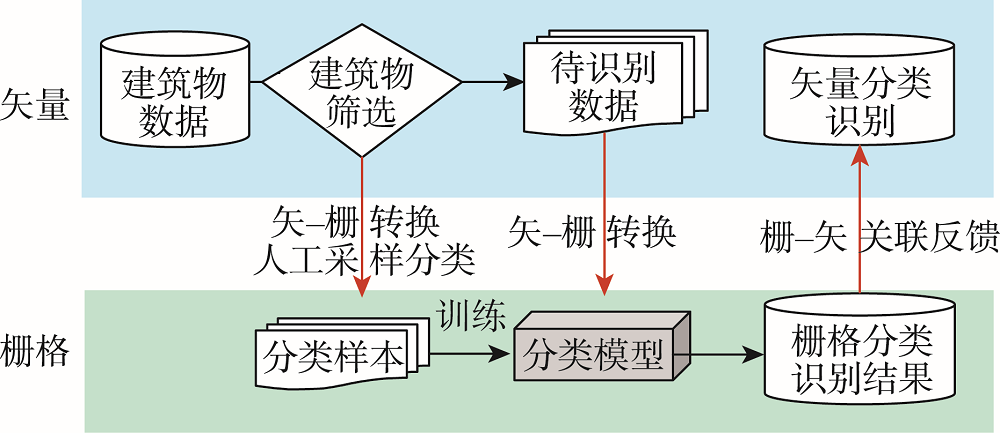

Journal of Geo-information Science >
Map Building Shape Classification Method based on AlexNet
Received date: 2021-07-14
Revised date: 2021-09-09
Online published: 2023-02-25
Supported by
National Natural Science Foundation of China(42071450)
National Natural Science Foundation of China(41801396)
National Natural Science Foundation of China(62101395)
Shape of map objects plays an important role in the study of map generalization and spatial query. As the basis of simplification and typification of building, the recognition and classification of map building shapes has always been a hot issue in cartographic generalization research. At present, the traditional building shape recognition methods mainly rely on the description of the building boundary and a specific shape similarity calculation, which can only be applied to buildings with conventional shapes. The traditional methods have a strong dependence on the morphological characteristics of map surface elements such as buildings, and usually only play a good role in dealing with specific types of regular contours or rectangular contours, but has poor shape recognition ability for buildings with complex or unusual shapes. This study proposes a new method of map building shape classification method based on AlexNet. The shape classification problem of building data in vector map is transformed into the classification problem of building raster images, and the shape recognition of building is realized by completing the graphic classification of convolutional neural network. Firstly, this method constructs a series of typical shape types based on spatial cognition. Secondly, the raster images of individual buildings are sampled from OSM data by vector-raster transformation method, and the training samples of building shape classification are obtained through manual identification. Based on this, the classification model of AlexNet convolutional neural network is trained. Thirdly, this method uses the trained model to perform intelligent shape classification and recognition on large-scale building data. In this paper, the OSM building data of Beijing and Hong Kong were used as samples to train the building shape classification model, and the proposed method was verified using the OSM building data of some urban areas in Guangzhou. Compared with the traditional shape similarity measurement method, the recall rate of the proposed method increased by 2.48% (92.32%) for the classification of buildings in the experimental area. The precision rate of more complex shapes such as T shape and cross shape was also higher, which increased by 13.83% and 24.53%, respectively. The experimental results show that the proposed method can significantly improve the classification accuracy of building shapes, and can effectively classify common building shapes, which lays a foundation for the next step of the map generalization such as the simplification and topicalization of buildings.

JIAO Yangyang , LIU Pingzhi , LIU Ailong , LIU Songlin . Map Building Shape Classification Method based on AlexNet[J]. Journal of Geo-information Science, 2022 , 24(12) : 2333 -2341 . DOI: 10.12082/dqxxkx.2022.210396
表1 14类建筑物典型形状对应样本示例Tab. 1 Samples of typical shapes of 14 types of buildings |
| 序号 | 典型形状类型 | 对应样本 | 序号 | 典型形状类型 | 对应样本 |
|---|---|---|---|---|---|
| 1 | 正方形 |   | 8 | Z形 |   |
| 2 | 直线形 |   | 9 | 圆形 |   |
| 3 | L形 |   | 10 | 廾字形 |   |
| 4 | 井字形 |   | 11 | C形 |   |
| 5 | 十字形 |   | 12 | H形 |   |
| 6 | T形 |   | 13 | 梯形 |   |
| 7 | U形 |   | 14 | 三叉形 |   |
表2 形状分类实验数据统计Tab. 2 Data statistics of shape classification experiment |
| 分类方法 | 类型 | 人工判别数/个 | 分类数/个 | 正确分类数/个 | 查全率/% | 查准率/% |
|---|---|---|---|---|---|---|
| 本文方法 | 正方形 | 3586 | 4211 | 3320 | 92.58 | 78.84 |
| T形 | 182 | 199 | 163 | 89.56 | 81.91 | |
| L形 | 56 | 67 | 49 | 87.50 | 73.13 | |
| 十字形 | 120 | 133 | 109 | 90.83 | 81.95 | |
| 传统方法 | 正方形 | 3586 | 3959 | 3262 | 90.96 | 82.39 |
| T形 | 182 | 213 | 145 | 79.67 | 68.08 | |
| L形 | 56 | 60 | 47 | 83.93 | 78.33 | |
| 十字形 | 120 | 155 | 89 | 74.17 | 57.42 |
| [1] |
武芳, 巩现勇, 杜佳威. 地图制图综合回顾与前望[J]. 测绘学报, 2017, 46(10):1645-1664.
[
|
| [2] |
王家耀. 普通地图制图综合原理[M]. 北京: 测绘出版社, 1993.
[
|
| [3] |
刘鹏程. 形状识别在地图综合中的应用研究[D]. 武汉: 武汉大学, 2009.
[
|
| [4] |
|
| [5] |
|
| [6] |
刘鹏程, 艾廷华, 胡晋山, 等. 基于原型模板形状匹配的建筑多边形化简[J]. 武汉大学学报·信息科学版, 2010, 35(11):1369-1372.
[
|
| [7] |
|
| [8] |
|
| [9] |
李德仁, 王树良, 李德毅, 等. 论空间数据挖掘和知识发现的理论与方法[J]. 武汉大学学报·信息科学版, 2002, 27(3):221-233.
[
|
| [10] |
|
| [11] |
|
| [12] |
何小飞, 邹峥嵘, 陶超, 等. 联合显著性和多层卷积神经网络的高分影像场景分类[J]. 测绘学报, 2016, 45(9):1073-1080.
[
|
| [13] |
|
| [14] |
|
| [15] |
马磊. 基于机器学习的建筑物形状化简模型[D]. 兰州: 兰州交通大学, 2018.
[
|
| [16] |
晏雄锋, 艾廷华, 杨敏, 等. 地图空间形状认知的自编码器深度学习方法[J]. 测绘学报, 2021, 50(6):757-765.
[
|
| [17] |
|
| [18] |
|
| [19] |
杜佳威, 武芳, 行瑞星, 等. 几种具有编解码结构的深度学习模型在建筑物综合中的应用与比较[J]. 武汉大学学报·信息科学版, 2021,DOI:10.13203/j.whugis20200143.
[
|
| [20] |
刘远刚, 李少华, 蔡永香, 等. 移位安全区约束下的建筑物群移位免疫遗传算法[J]. 测绘学报, 2021, 50(6):812-822.
[
|
| [21] |
|
| [22] |
|
| [23] |
晏雄锋, 艾廷华, 杨敏. 居民地要素化简的形状识别与模板匹配方法[J]. 测绘学报, 2016, 45(7):874-882.
[
|
/
| 〈 |
|
〉 |